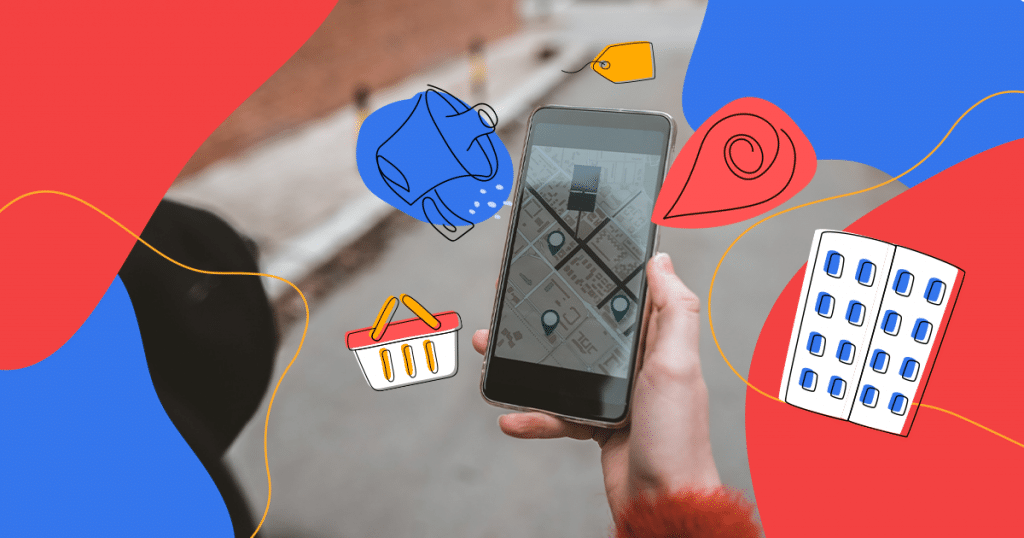Location-based marketing is a particular form of digital marketing that allows companies to target consumers on a more personal and individual level through online or offline messaging based on their actual (or physical) location.
You are essentially presented with the unique opportunity to send consumers personalized and relevant messaging directly to their mobile device, aiding in their movement further down the sales funnel.
The opportunities available with this type of advertising are virtually endless.
Since people are constantly on their smartphones, why not use that to your advantage to draw them into your business and encourage them to make a purchase?
If your business has not yet begun implementing geofencing advertising, now is the time to start. Here’s what you’ll learn in this article.
What is Geofencing Advertising?
Also referred to as geofencing marketing, geofencing advertising is a specific form of location-based marketing that allows you to connect with and advertise to mobile users in a designated area.
This designated area can be defined by a zip code, city, county, state, country, etc. You can even narrow it down to a couple of blocks if you want.
Geofencing allows you to reach your target audience in brand-new ways, as it works with 92 percent of all smartphones.
As a result, you have the capability of significantly increasing your bottom line.
What are the Benefits of Geofence Advertising?
The benefits of geofencing advertising are truly endless for both brands and marketers, and this is true for those who have an online presence or a brick-and-mortar storefront.
If geofence advertising is something you are considering, here are just a few of the benefits you’ll reap.
Increased Local Sales/Local Marketing
People have always enjoyed getting out of their homes and walking around looking through the windows of shops.
However, it is so much more than that now.
The COVID-19 pandemic changed Americans. After having to stay in their homes to eat, shop, and just social distance, they want their lives back. They want to socialize, shop, eat out, and more. In fact, 71% just want to walk around town!
Because of this, it is more important than ever to target these individuals as they strive to get their lives back and are walking past your shop (and others).
With that being said, location-based marketing has the potential to take your brand to soaring heights.
With a geofence, promotions can be sent to users via push notification as they enter a set perimeter.
These promotions can be limited-time offers or changed daily, which will help increase sales from your local customers.
Boost Brand Awareness
Geofencing advertising can also increase your brand awareness.
It isn’t uncommon for people who are walking around town to not notice every store or shop that they pass by. They see what they want to see. Ultimately, they notice what they are interested in or what they are looking for.
So, if they are not looking for a bakery or simply aren’t interested in food at the moment due to possibly shopping for a wedding gown, they may not notice it.
However, if they receive a targeted ad on their smartphone, they are more likely to notice your bakery when they pass by it and stop in.
The ads that are used with geofences offer your company the chance to remind customers that you are there and ready to serve them.
As a result, this allows them to be more aware of your brand and location then and in the future.
Increased Analytics
It can be incredibly difficult to measure the efficiency of your local marketing campaign and local sales.
For instance, how do you know what it is that brings people to your store? How do you determine how long they stay in your store? How can you figure out how many times they visit your shop?
All of these metrics are easily measured when you have an online website, but they aren’t so easily measured when you have a brick-and-mortar store.
However, when you are sending out promotions to users via geofencing advertising, you have the capability of obtaining data on consumer behavior.
By gaining access to similar data you would get from online metrics, you can improve both your targeting and advertising methods, thereby improving your overall geofencing marketing results.
How Does Geofencing Advertising Work?
Geofencing advertising may sound complicated, but the process is relatively straightforward.
Geofencing works by utilizing a combination of GPS, Bluetooth, Wi-Fi, and radio-frequency identification (RFID).
Basically, there are three steps to the process of geofencing marketing.
- The first step is to create a virtual “fence” around a physical location, such as a store. You also must develop an ad campaign that is specifically targeted for this geofenced area.
- The second step involves a potential customer, along with their smartphone, entering into this geofenced location or boundary that has previously been set up.
- The third step is an advertisement being triggered once the prospective customer enters the geofenced area and being displayed on the user’s smartphone. This advertisement may be delivered to the user via display ads, search ads, in-app ads, or notifications.
A practical example
So, let’s say that you own a bakery, and to be put simply, you aren’t the only bakery on the block — and definitely not within a several block radius.
With that being said, you want to get a leg up on your competitors.
With geofence advertising, you are able to create a virtual boundary around a specific geographic area. This can be a mile or within just several blocks.
Whatever you choose, once someone with a smartphone enters that geotargeted perimeter, they will become a member of your targeted audience and begin receiving advertisements from your marketing campaign (usually up to 30 days).
Your geofence doesn’t have to be placed around your actual business location. You can place it around your competitor’s location.
So, in the case of the bakery example above, the geofence can be placed around a competing bakery. Alternatively, you could set up multiple geofences.
Geofencing Advertising: Best Practices
Now that you know what geofencing is, the benefits of geofencing advertising, and how it works, it’s time to learn how to actually reap the benefits.
Here are a few best practices to keep in mind as you put together a geofencing advertising campaign on your preferred platform (Google Ads, Facebook, or Instagram, for example).
Create a Geofence of Appropriate Size
As a newbie to geofencing, the last thing you want to do is create a geofence that is too large. An oversized geofence will not allow you to reap the results you hope to achieve.
For instance, creating a geofence around a competitor who is 30 minutes away from you is not very strategic, as a consumer is highly unlikely to simply drive 30 minutes that same day under most circumstances.
This will leave you spending unnecessary money on ads that aren’t likely to convert.
Therefore, you want to focus on smaller, more compact geofence perimeters.
A good rule of thumb is to create a geofence that is within about five minutes of your store. This can be a five-minute walking or driving distance.
Convenience is key here for potential customers.
Know Your Target Audience
In order for geofencing advertising to be successful, you must identify and become familiar with your target audience.
By understanding who your audience is and what they want, you can create a geofence and an advertisement that will ultimately drive the best possible results.
Essentially, you want to build a buyer persona, identifying your customer’s gender, age range, interests, and overall shopping behaviors.
In doing so, you can improve the accuracy of your ad targeting. Try to determine what consumers like about your brand and what draws them to your company.
If you are unsure about your target audience and have an online presence, you can obtain much of this information on social media and from current online metrics.
Create Actionable Advertisements
As you are creating your advertisements to be sent to potential customers, you want to ensure these ads are actionable and inviting.
You want mobile users to take action as soon as they see these ads on their mobile devices.
Be short, concise, and specific in your call-to-action advertisement. Make sure that the user understands the urgency of the advertisement as well, prompting them to come in as soon as possible.
For example:
- Stop by for our lunch special!
- Buy one pastry, get one free; only today!
Although both of these examples are great, the latter is short, concise, and specific by informing potential customers of how much they save while also showing the urgency of the deal.
One report has shown that the best-performing CTAs for geofencing ads include the following:
- Learn More
- Shop Now
- Buy Now
- Click Here
- Order Now
- Click to Save
- Call Now
- Shop Online
Best Examples of Brands Using Geofencing Advertising
One of the best ways for you to see how to effectively put geofencing advertising to work for your brand is by seeing it in action.
Geofencing marketing is used by companies of all shapes, sizes, and industries. It is used by companies that operate online and offline.
Let’s take a look at a few of the most well-known brands that have used geofencing advertising effectively and found success with it.
Hopefully, these examples will help inspire your own geofencing campaign.
#1: American Eagle
As a popular apparel company, most commonly found in shopping malls, American Eagle has found success using geofencing advertising.
This company focused on creating a fence around shopping malls so potential customers would receive notifications/advertisements as soon as they entered the mall parking lot.
American Eagle was successful with its targeted campaign, as its sales increased threefold.
#2: Burger King
Burger King utilized geofencing advertising to create a geofence within 600 feet of various McDonald’s restaurants throughout the country.
When users entered this perimeter, it would trigger an ad that would let them know they could download the Burger King app and download a coupon to receive a Whopper for a penny.
With this promotion, Burger King reported 1.5 million app downloads, 3.3 billion impressions, and $37 million in earned media.
They saw 3x as many mobile sales during the promotional period and customers redeemed over 500,000 Whoppers. They had twice as many sales through their app after the promotion ended!
#3: Starbucks
Starbucks is the most popular coffee company in the country, and it is successful in utilizing geofencing technology to send push notifications to consumers when they are within a certain range of a Starbucks location.
The brand will send personalized advertisements to customers for specials on their favorite drinks to try to get them through their doors.
Some other specials they often send out include BOGO, happy hour specials, etc.
#4: Sephora
Sephora is well-known for its in-store notifications.
Referred to as the “Store Companion,” the mobile app pops up on a user’s mobile phone as soon as they enter the store.
The app has the ability to pull up previous purchases, reviews, product recommendations, limited-edition offers, as well as so much more.
With geofencing technology, Sephora enhances the customer experience while in the store and helps increase customer loyalty.
Wrap Up
Personalized marketing through geofencing advertising is an effective way to reach your overall target audience.
Due to the fact that 80 percent of consumers are far more likely to buy from a brand that offers personalized experiences, it goes without saying that you need to ensure you are focused on reaching the right people.
While geofencing advertising may bring smartphone users into your store or to your website, you don’t want to neglect other ways to improve your online presence and Google SERP ratings.
Check out this blog to learn more about attracting customers with local SEO!



![[ROCK NA] [EBOOK SEO] Complete Guide](https://rockcontent.com/wp-content/uploads/2024/06/banner_Search-Engine-Optimization.png)






